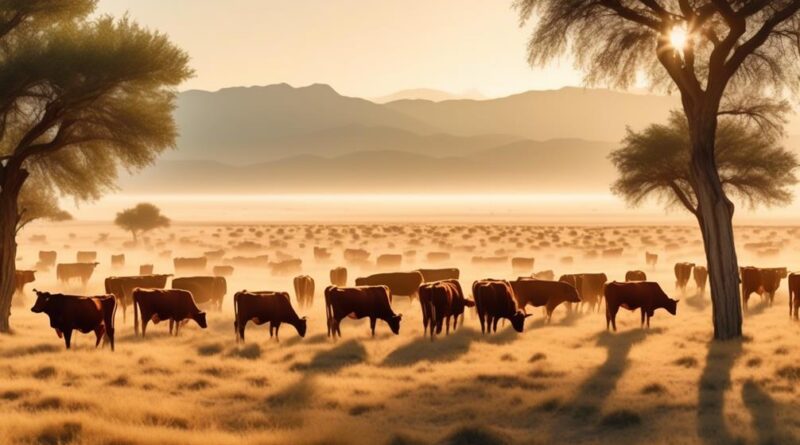What Drought-Resistant Forage Is Best for Cattle Grazing?
So, you've found yourself facing the challenge of maintaining your cattle's grazing supply during less than ideal conditions. When it comes to selecting the best drought-resistant forage for your cattle, you want to make sure you're equipped with the most effective options.
But with the wide array of choices available, how do you determine which forage will truly benefit your herd while also withstanding drought conditions?
Stay tuned to discover the optimal drought-resistant forage that will not only provide sustenance for your cattle but also withstand the toughest of dry spells.
Benefits of Drought-Resistant Forage
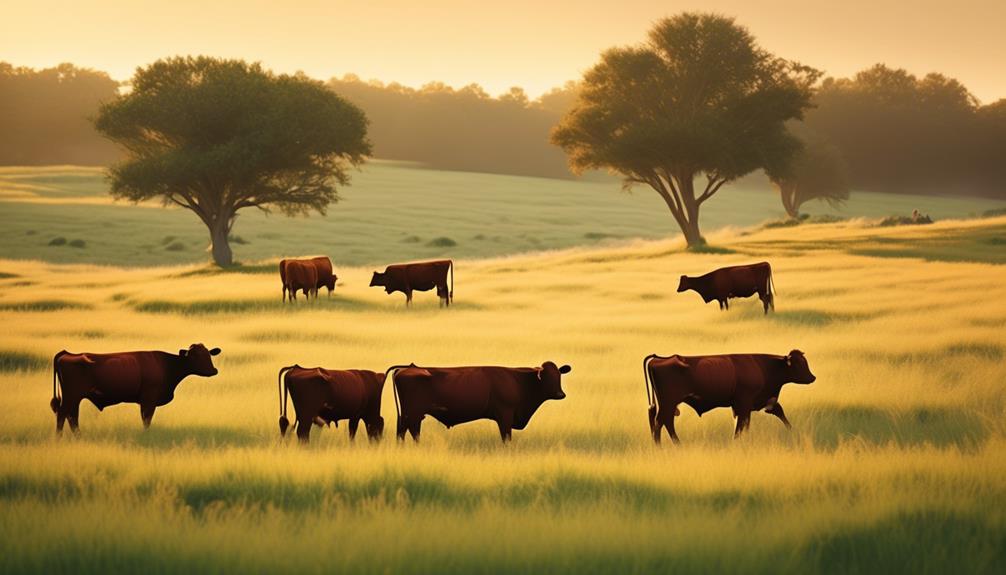
Drought-resistant forage offers cattle a reliable source of nutrition even in challenging dry conditions. When considering the benefits of drought-resistant forage, one crucial aspect is its impact on soil fertility. These forage plants have deep root systems that help prevent soil erosion and improve soil structure. As a result, they contribute to maintaining soil fertility even in arid environments, which is essential for sustainable grazing.
Another significant benefit is their climate adaptability. Drought-resistant forage plants are adept at thriving in harsh conditions, making them a dependable resource for cattle grazing in areas prone to drought. By providing a consistent source of nutrition, these forage plants support the overall health and well-being of the cattle, even when traditional forage options may be scarce.
Moreover, their ability to endure dry spells without significant loss of quality makes them a valuable asset for cattle ranchers. These forage plants ensure that cattle have access to essential nutrients, promoting healthy growth and productivity. Additionally, the reliable availability of drought-resistant forage alleviates the pressure on natural pastures, allowing for better management of grazing lands.
Types of Drought-Resistant Forage
With the benefits of drought-resistant forage in mind, consider the various types of forage plants that exhibit resilience in challenging dry conditions. When it comes to forage selection, it's essential to prioritize drought tolerance to ensure the sustainability of cattle grazing operations.
One popular option is the use of warm-season grasses such as Bermuda grass and Bahia grass. These grasses have deep root systems that enable them to access water from lower soil layers during dry spells. They also have the ability to go dormant during extended periods of drought and quickly recover once moisture returns.
Another valuable choice is the utilization of legumes like alfalfa and clover. These species have taproots that help them reach deep water reserves and can fix nitrogen in the soil, promoting overall pasture health. Additionally, forage sorghums and millets are known for their ability to withstand drought conditions and provide nutritious forage for cattle.
It's crucial to consider the specific requirements of the cattle, the climate of the region, and the overall grazing management plan when making forage selections. By incorporating a variety of drought-resistant forage types, you can create a diverse and resilient grazing environment that ensures a consistent and reliable food source for your cattle.
Grazing Management Techniques
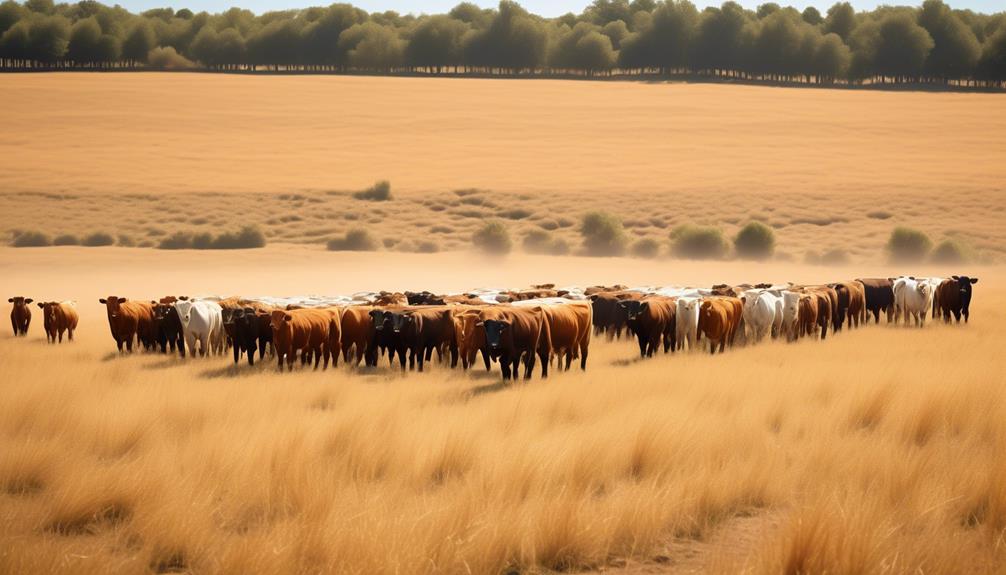
To effectively manage grazing for your cattle, implement strategic rotational grazing to optimize forage utilization and pasture health. Rotational grazing involves dividing your pasture into smaller paddocks and regularly rotating the cattle between them. This technique offers several benefits for your herd and the land they graze on.
- Grazing Efficiency: By rotating your cattle through different paddocks, you prevent overgrazing in one area while allowing other sections to recover. This ensures that your cattle have a steady supply of high-quality forage throughout the grazing season.
- Pasture Rotation: Implementing a rotational grazing system helps maximize the use of available forage. This not only benefits your cattle but also promotes the overall health of your pasture. It allows for better distribution of manure, which can enhance soil fertility and health.
- Drought Tolerant Species and Soil Health: Introducing drought-tolerant forage species into your pasture can contribute to soil health and resilience during dry periods. These species are often deep-rooted and can help improve water infiltration, reduce erosion, and enhance the overall stability of your pasture ecosystem.
Nutritional Value for Cattle
Maximizing the nutritional value of your pasture for cattle grazing involves understanding the diverse range of forage options available and their impact on herd health and productivity. When selecting drought-resistant forage, it's crucial to consider the protein content and digestibility. For cattle, protein is essential for growth, reproduction, and overall health. Legumes such as alfalfa and clover are known for their high protein content, making them valuable forage options. Additionally, grasses like fescue and Bermuda grass also provide decent protein levels and are widely utilized in drought-prone regions.
Energy value is another vital aspect to consider. Cattle require sufficient energy for body maintenance, growth, and lactation. Forage with good energy content, such as warm-season grasses like switchgrass or big bluestem, can be valuable during dry periods.
Palatability is equally important, as it influences the amount of forage cattle consume. While cattle can adapt to various forages, their preference for certain types can affect overall intake and, consequently, nutritional value. For example, some drought-resistant forages may have lower palatability, leading to decreased consumption.
Best Practices for Planting
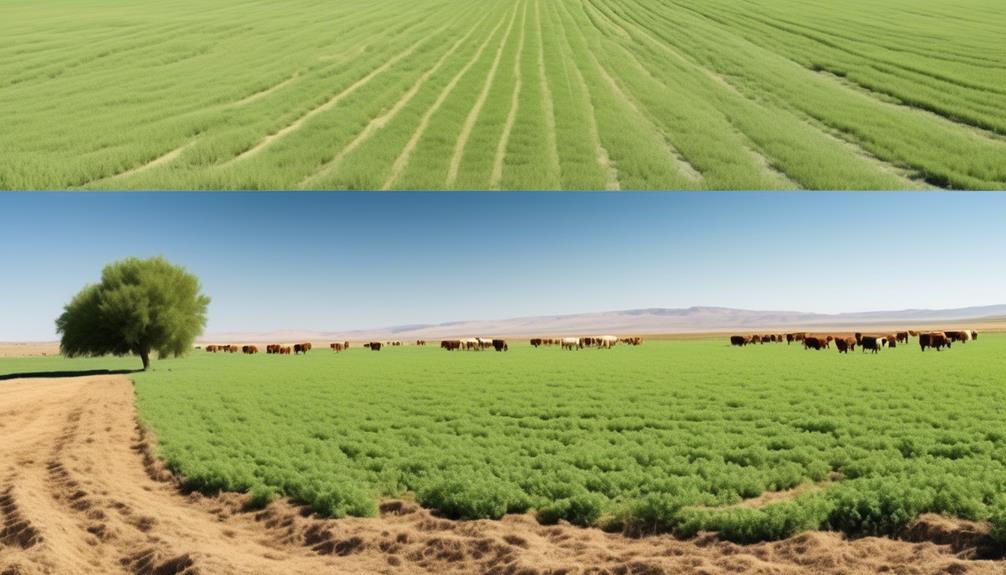
Consider incorporating drought-resistant forage into your grazing strategy to ensure success in planting for your cattle. To maximize the benefits of drought-resistant forage, it's important to follow best practices for planting. Here are some key factors to consider:
- Soil Preparation:
- Assess the soil quality and ensure it's well-drained to prevent waterlogging, which can be detrimental to drought-resistant forage.
- Remove any weeds or debris from the planting area to reduce competition for nutrients and water.
- Planting Timing:
- Choose the appropriate time for planting based on the specific forage species and your local climate conditions.
- Planting during the early stages of the growing season can help the forage establish strong roots before the onset of drought conditions.
- Fertilization and Irrigation Techniques:
- Conduct a soil test to determine any deficiencies and apply fertilizers accordingly to promote healthy forage growth.
- Implement efficient irrigation techniques such as drip irrigation or moisture sensors to optimize water usage and ensure the forage receives adequate moisture during dry periods.
Forage Rotation Strategies
You can enhance your cattle grazing efficiency by implementing effective forage rotation strategies. By rotating your forage crops, you can improve soil health and control weeds, ultimately providing your cattle with a better grazing environment.
Soil health is crucial for sustainable forage production. Implementing a forage rotation strategy helps maintain soil fertility and structure. Legumes such as clover and alfalfa, when included in the rotation, contribute to soil health by fixing nitrogen and improving soil nutrient levels. Rotating these legumes with grasses can also break pest and disease cycles, promoting overall soil health and reducing the need for chemical inputs.
Weed control is another essential aspect of forage rotation strategies. Continuous grazing on the same forage can lead to an increase in weed populations. Rotating to a different forage species or planting cover crops can disrupt weed growth cycles, reducing weed pressure in pastures. Additionally, certain forage species, such as sorghum-sudangrass, have allelopathic effects that suppress weed growth, further aiding in weed control efforts.
Incorporating strategic forage rotations not only benefits your cattle's nutrition but also contributes to the long-term health of your grazing land. By prioritizing soil health and weed control through effective forage rotation strategies, you can optimize your cattle grazing operations while promoting sustainable land management practices.
Water-Efficient Forage Options
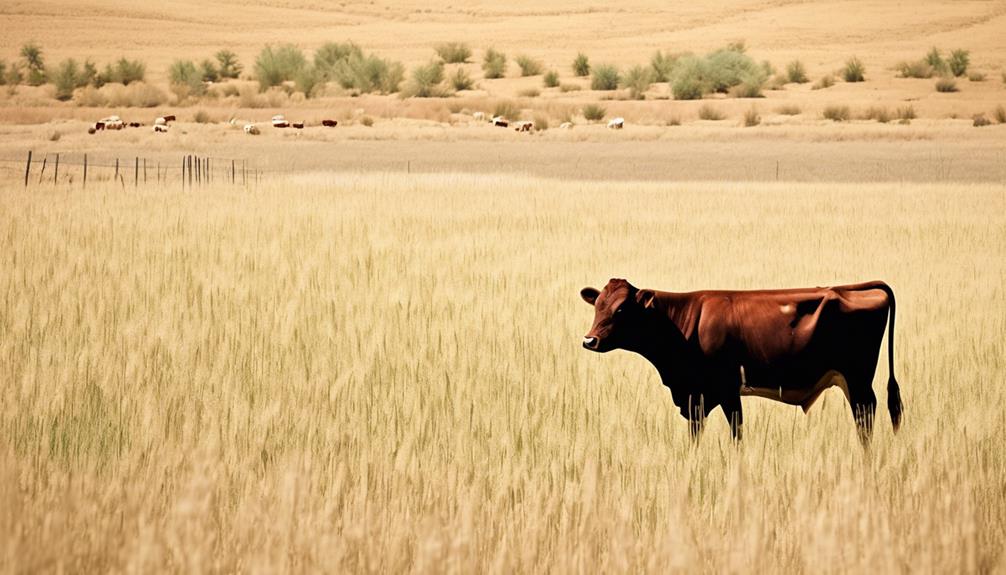
When selecting forage options, prioritize those with high water efficiency to ensure sustainable grazing practices. By choosing water-efficient forage, you can effectively manage your herd's nutritional needs while conserving water resources. Here are some water-efficient forage options to consider:
- Forage Species Selection
- Opt for deep-rooted forage species such as alfalfa and birdsfoot trefoil, which can access water deep in the soil, reducing the need for frequent irrigation.
- Consider warm-season grasses like Bermuda grass and buffelgrass, which have high drought tolerance and can thrive with minimal water input.
- Incorporate legumes like clover and lespedeza into your forage mix, as they've nitrogen-fixing abilities that enhance soil fertility, reducing the need for additional water and fertilizer.
By focusing on these water-efficient forage options, you can mitigate the impact of drought conditions on your grazing operations. Additionally, improving soil fertility through strategic forage selection can further enhance water retention and nutrient availability for your forage crops.
When you prioritize water-efficient forage options, you not only support sustainable grazing practices but also contribute to the long-term health of your grazing lands.
Handling Drought-Related Challenges
Amidst drought conditions, proactive management strategies for cattle grazing are essential to ensure herd health and sustainable forage production. Water conservation becomes paramount during droughts. Implementing water-saving techniques such as efficient irrigation systems and ensuring proper hydration for the cattle is crucial. It's important to monitor water sources closely and consider alternative water supplies if needed.
Additionally, soil health plays a critical role in mitigating the impacts of drought. Practices such as rotational grazing and maintaining ground cover help to preserve soil moisture and prevent erosion, thus ensuring the long-term sustainability of forage production.
During drought, it's crucial to manage grazing pressure effectively. Rotational grazing can help to prevent overgrazing, allowing forage to recover more quickly during intermittent rain. Planning forage planting according to drought-resistant species and diversifying forage options can also aid in maintaining cattle nutrition during dry spells. Monitoring forage quality and quantity becomes even more important to ensure the herd's nutritional needs are met.
In addition to these strategies, maintaining the overall health and condition of cattle is essential during drought. This includes providing mineral supplements and ensuring vaccinations are up to date to support the herd's immune system. Most importantly, staying informed about drought conditions and seeking guidance from agricultural extension services can provide valuable insights and support for managing cattle grazing during challenging times.
Frequently Asked Questions
How Do Drought-Resistant Forage Options Compare in Terms of Cost and Availability?
When it comes to drought-resistant forage options for cattle grazing, it's important to consider the cost comparison and availability analysis. Some options may be more cost-effective while others could be more readily available.
Can Drought-Resistant Forage Be Used for Other Livestock, Such as Sheep or Goats?
You can use drought-resistant forage for other livestock like sheep or goats. Consider grazing compatibility, nutrient content, soil health, and water usage. Evaluate options based on your specific needs and environmental conditions.
Are There Any Potential Drawbacks or Limitations to Using Drought-Resistant Forage for Cattle Grazing?
When using drought-resistant forage for cattle grazing, there may be drawbacks like reduced productivity during extreme dry spells. However, overall sustainability and resilience make it a great option, with some limitations to consider.
What Are the Potential Environmental Benefits of Using Drought-Resistant Forage for Cattle Grazing?
Using drought-resistant forage for cattle grazing brings potential environmental benefits. It promotes sustainable agriculture by conserving water and maintaining soil health. This approach can help mitigate the impact of drought on grazing lands.
Are There Any Specific Considerations or Recommendations for Using Drought-Resistant Forage in Different Geographic Regions or Climates?
Consider soil conditions and water requirements when selecting drought-resistant forage. Adaptability to different climates is crucial. Assess grazing patterns and geographic regions to determine which forage is best suited for cattle in specific areas.
Conclusion
In conclusion, when it comes to choosing the best drought-resistant forage for cattle grazing, consider the benefits, types, and nutritional value.
Implement grazing management techniques and planting best practices to maximize the forage's potential.
Incorporate forage rotation strategies and water-efficient options to address drought-related challenges.
By taking these factors into account, you can ensure that your cattle have access to high-quality forage even during periods of drought.
